A comic strip is a sequence of cartoons, arranged in interrelated panels to display brief humor or form a narrative, often serialized, with text in balloons and captions. Traditionally, throughout the 20th and into the 21st century, these have been published in newspapers and magazines, with daily horizontal strips printed in black-and-white in newspapers, while Sunday papers offered longer sequences in special color comics sections. With the advent of the internet, online comic strips began to appear as webcomics.

The Katzenjammer Kids is an American comic strip created by Rudolph Dirks in 1897 and later drawn by Harold Knerr for 35 years. It debuted on December 12, 1897, in the American Humorist, the Sunday supplement of William Randolph Hearst's New York Journal. The comic strip was turned into a stage play in 1903. It inspired several animated cartoons and was one of 20 strips included in the Comic Strip Classics series of U.S. commemorative postage stamps.

The National Cartoonists Society (NCS) is an organization of professional cartoonists in the United States. It presents the National Cartoonists Society Awards. The Society was born in 1946 when groups of cartoonists got together to entertain the troops. They enjoyed each other's company and decided to meet on a regular basis.

The Yellow Kid is an American comic-strip character that appeared from 1895 to 1898 in Joseph Pulitzer's New York World, and later William Randolph Hearst's New York Journal. Created and drawn by Richard F. Outcault in the comic strip Hogan's Alley, it was one of the first Sunday supplement comic strips in an American newspaper, although its graphical layout had already been thoroughly established in political and other, purely-for-entertainment cartoons. Outcault's use of word balloons in the Yellow Kid influenced the basic appearance and use of balloons in subsequent newspaper comic strips and comic books.

Peanuts is a syndicated daily and Sunday American comic strip written and illustrated by Charles M. Schulz. The strip's original run extended from 1950 to 2000, continuing in reruns afterward. Peanuts is among the most popular and influential in the history of comic strips, with 17,897 strips published in all, making it "arguably the longest story ever told by one human being"; it is considered to be the grandfather of slice of life cartoons. At the time of Schulz's death in 2000, Peanuts ran in over 2,600 newspapers, with a readership of roughly 355 million across 75 countries, and had been translated into 21 languages. It helped to cement the four-panel gag strip as the standard in the United States, and together with its merchandise earned Schulz more than $1 billion.

Gasoline Alley is a comic strip created by Frank King and distributed by Tribune Content Agency. It centers on the lives of patriarch Walt Wallet, his family, and residents in the town of Gasoline Alley, with storylines reflecting traditional American values.

Addison Morton Walker was an American comic strip writer, best known for creating the newspaper comic strips Beetle Bailey in 1950 and Hi and Lois in 1954. He signed Addison to some of his strips.

Richard Felton Outcault was an American cartoonist. He was the creator of the series The Yellow Kid and Buster Brown and is considered a key pioneer of the modern comic strip.

Alley Oop is a syndicated comic strip created December 5, 1932, by American cartoonist V. T. Hamlin, who wrote and drew the strip through four decades for Newspaper Enterprise Association. Hamlin introduced a cast of colorful characters and his storylines entertained with a combination of adventure, fantasy, and humor. Alley Oop, the strip's title character, is a sturdy citizen in the prehistoric kingdom of Moo. He rides his pet dinosaur Dinny, carries a stone axe, and wears only a fur loincloth.

Hi and Lois is an American comic strip about a suburban family. Created by Mort Walker and illustrated by Dik Browne, both of whose children currently work on the strip, it debuted on October 18, 1954, distributed by King Features Syndicate.
A daily strip is a newspaper comic strip format, appearing on weekdays, Monday through Saturday, as contrasted with a Sunday strip, which typically only appears on Sundays. They typically are smaller, 3–4 grids compared to the full page Sunday strip and are black and white.

The Sunday comics or Sunday strip is the comic strip section carried in most western newspapers. Compared to weekday comics, Sunday comics tend to be full pages and are in color. Many newspaper readers called this section the Sunday funnies, the funny papers or simply the funnies.
Sam's Strip was a humorous comic strip created and produced by Mort Walker and Jerry Dumas. It was distributed by King Features Syndicate from October 2, 1961 to June 1, 1963. The series depended heavily on metahumor and appearances by famous comic-strip characters.

Nemo, the Classic Comics Library was a magazine devoted to the history and creators of vintage comic strips. Created by comics historian Rick Marschall, it was published between 1983 and 1990 by Fantagraphics.

Toots and Casper is a family comic strip by Jimmy Murphy, distributed to newspapers for 37 years by King Features Syndicate, from December 17, 1918 to December 30, 1956. The strip spawned many merchandising tie-ins, including books, dolls, paper dolls, pins, bisque nodders and comic books.
Sam and Silo is an American comic strip created by Mort Walker and Jerry Dumas, which began on April 18, 1977. The series is a "continuation" or a spin-off of Sam's Strip (1961-1963), as it uses the same characters. Dumas was solely responsible for the strip from 1995 and drew it until his death in 2016.

Hicksville is a graphic novel by Dylan Horrocks originally published by Black Eye Comics in 1998. The novel explores the machinations of the comic book industry, and contains a slightly fictionalized account of the history of mainstream American comics, with particular attention paid to the era of Image Comics.
Richard "Rick" Marschall is an American writer, editor, and comic strip historian, described by Bostonia magazine as "America's foremost authority on pop culture." Marschall has served as an editor for both Marvel and Disney comics, plus several syndicates.

Sylvan S. Byck (July 17, 1904 – July 8, 1982 was an American editor and cartoonist, who was the comic strip editor for King Features Syndicate for over 30 years, in which position he evaluated "up to 2000 comics submissions a year."
















